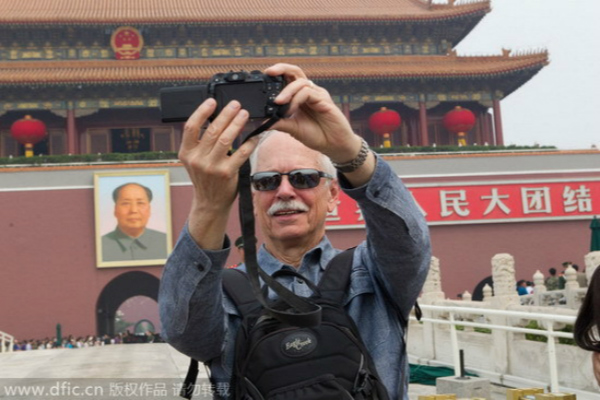China needs to further tap inbound tourism potential, study shows
Updated: 2016-03-22 17:54
By Liu Jing in London(chinadaily.com.cn)
|
|||||||||
 |
|
A foreign tourist takes selfies in front of the Tiananmen Rostrum during the May Day holiday in Beijing, China, May 1, 2014. [Photo/IC] |
Last year, the most popular destinations for overseas tourists in 2015 were Shanghai, Beijing and Guangzhou. "Currently the traditional ports of entry are still mainstream destinations but the path of passenger flow needs to diversify," said Yang.
Promotion was also listed by WTTC as a key issue to help tap inbound potential.
"China has so many different cultures, most of which are outside the big cities. But the country needs to market all that under the umbrella of a Chinese national brand to compete with other countries instead of every provinces and city promoting themselves, " Scowsill said.
Travel agencies are gradually noticing that their products need to be more tailored for today's travelers,
Yu Liangbing, China CYTS Tours' deputy general manager for inbound tourism, said his company now handled 40 percent fewer overseas tourists compared with the peak in 2007. The biggest source of tourists received by his company is the US, followed by Japan, Germany and UK. Among them, about 30 percent choose individual tours instead of package tour.
"The inbound tourism industry still has room to exist and develop," Yu said. "This is our opportunity to expand as many competitors are retreating and our future direction will be more focused on offering services for independent tourists."
The WTTC's Scowsill said he believes that the Chinese government still has enough motivation to develop inbound tourism.
"China is one of the best examples globally to be focused on in our industry," he said, noting that the country has recognized tourism as one of the five pillars of the Chinese economy long ago and the infrastructure construction undergoing is forward-looking.
According to the Civil Aviation Administration of China, by 2020 the country will have 260 civil airports. About 19,000 kilometers of high speed rail were operating by the end of 2015. The number is expected to reach 30,000 by 2020.
Currently the travel and tourism industry supports over 65 million jobs in China, representing 8.4 percent of the workforce. But this is below the global average of 9.8 percent, emphasizing the further room for growth in travel and tourism's contribution to employment, according to the WTTC report.
The report predicts that visitor exports from tourism, in other words the money spent, could increasingly help contribute to the Chinese economy as exports in some traditional manufacturing sectors seem to be slowing down.
Praising China's recent measures in offering tax refunds and visa-free transit in some cities, the WTTC's Scowsill said that another priority for China is to further simplify visa processing and expand its visa waiver program with other countries.
"China should try to make visas electronic, which is safer as well as more customer-friendly," he said.
To contact the reporter: liujing-4@chinadaily.com.cn
Related Stories
Plenty of room for growth for inbound tourism 2016-03-29 08:38
Chocolate, beer: People fear attacks will hurt tourism 2016-03-29 08:14
Visit highlights China's role in tourism 2016-03-27 14:21
New media to play major role in promoting holistic tourism 2016-03-26 15:03
'Amazing' hike marks tourism year 2016-03-26 07:56
Today's Top News
Xi arrives in Czech Republic for state visit
Passengers released on Egypt hijacked plane
Panda to join Little Mole in new cartoon series
President optimistic for Sino-German cooperation
Info sharing 'is key' as Europe faces terror threat
Uneasy times as Belgium mourns the dead
Belgian bombing suspect still at large: Prosecutor
Belgian media withdraws reports of suspect's arrest
Hot Topics
Lunar probe , China growth forecasts, Emission rules get tougher, China seen through 'colored lens', International board,
Editor's Picks

|

|

|

|

|

|






